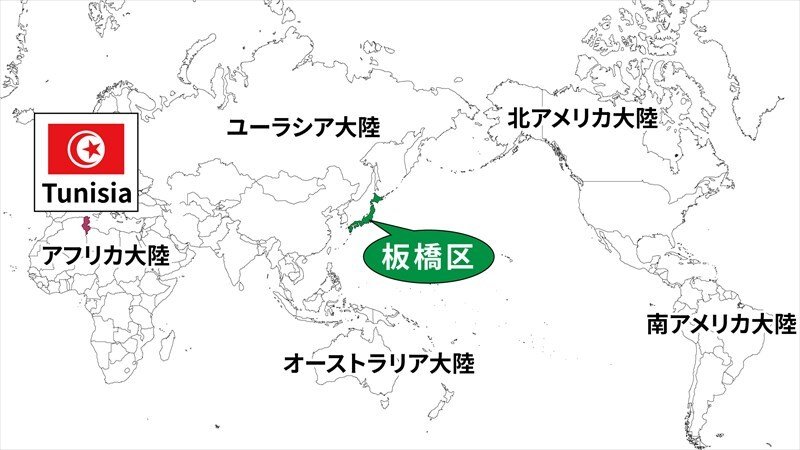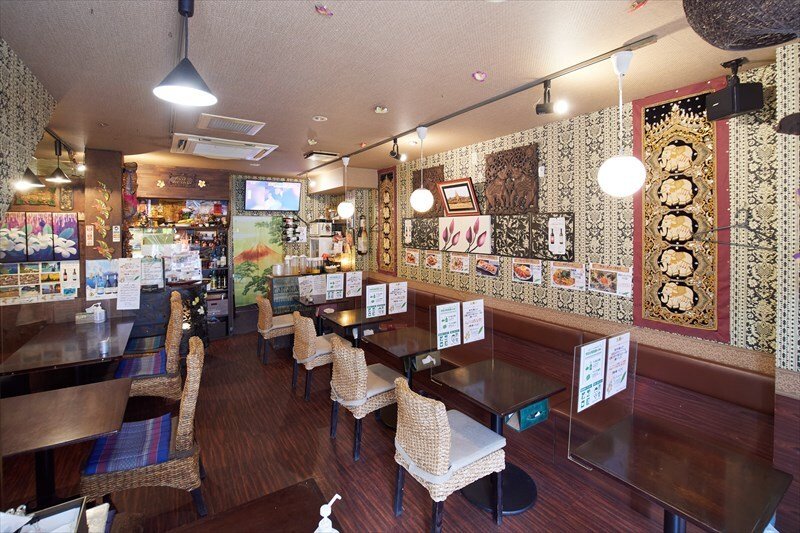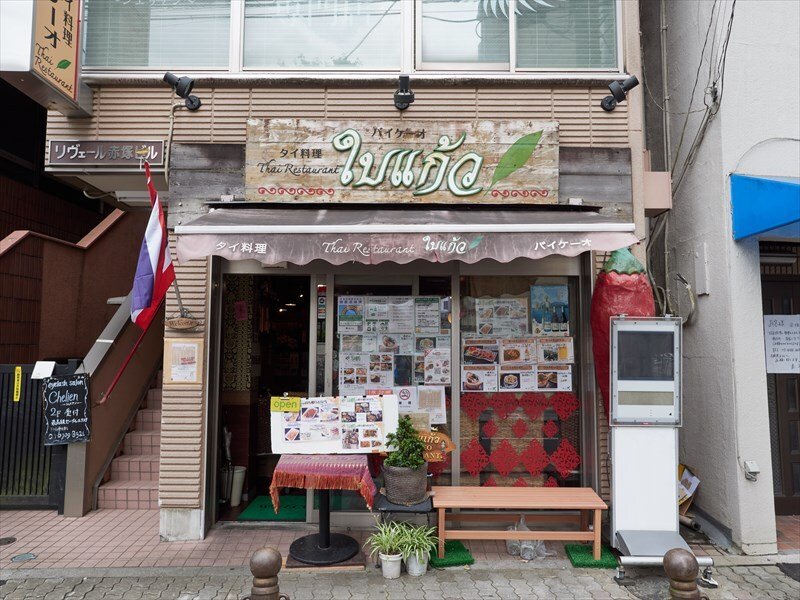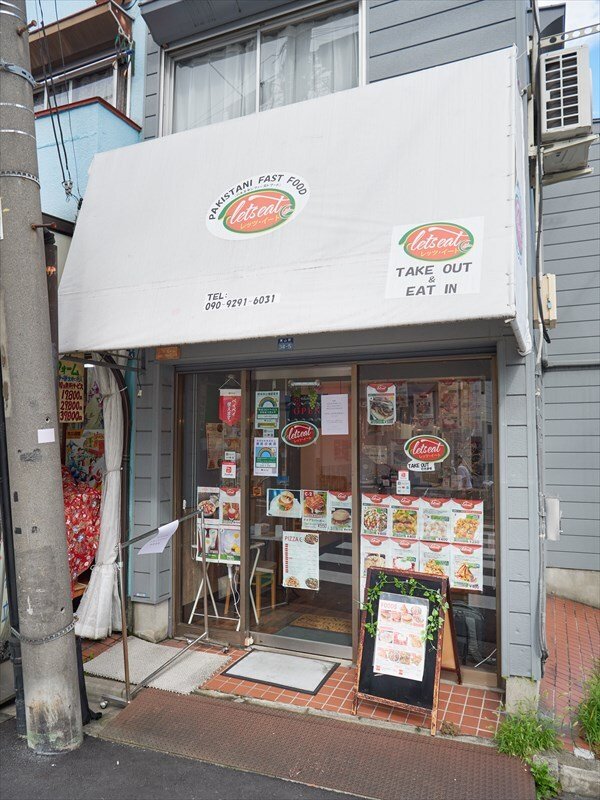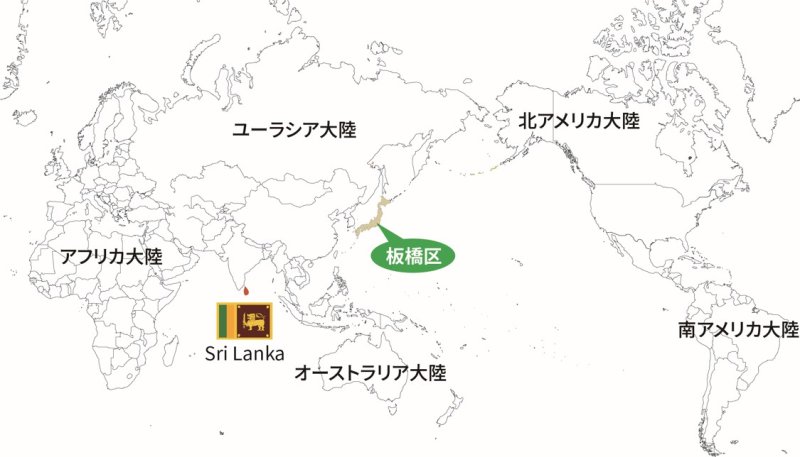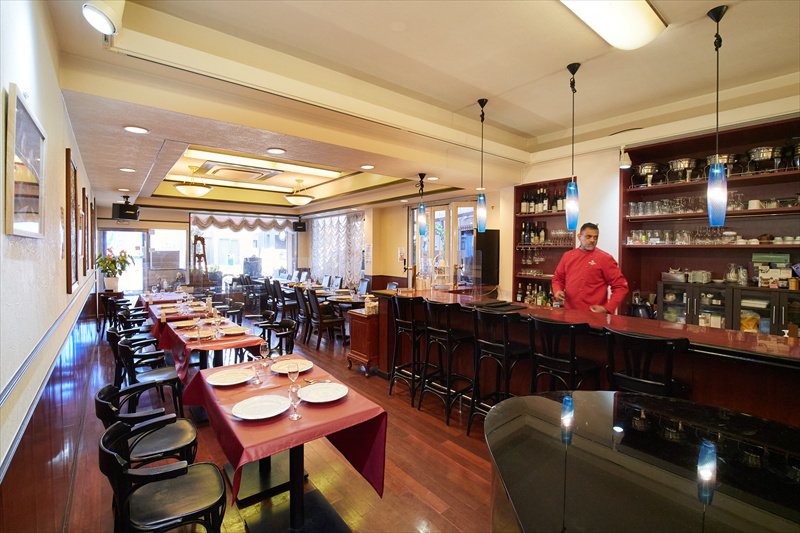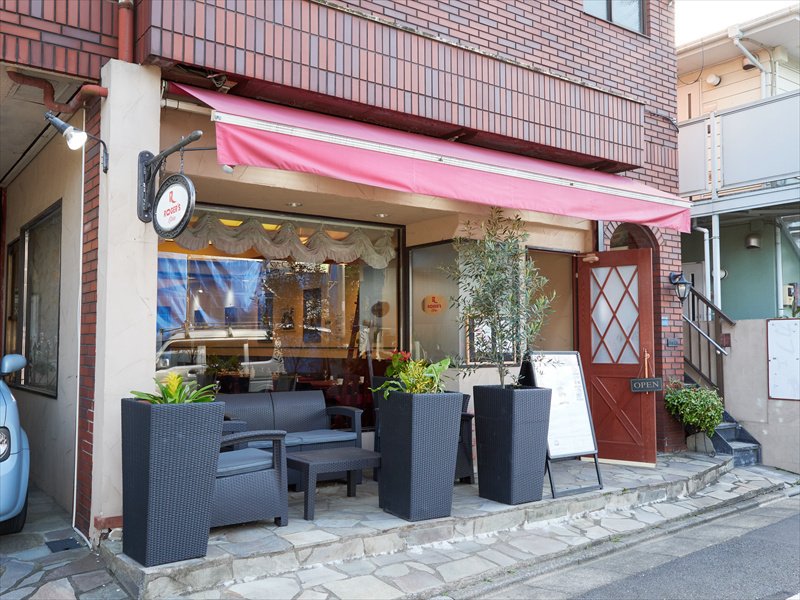-
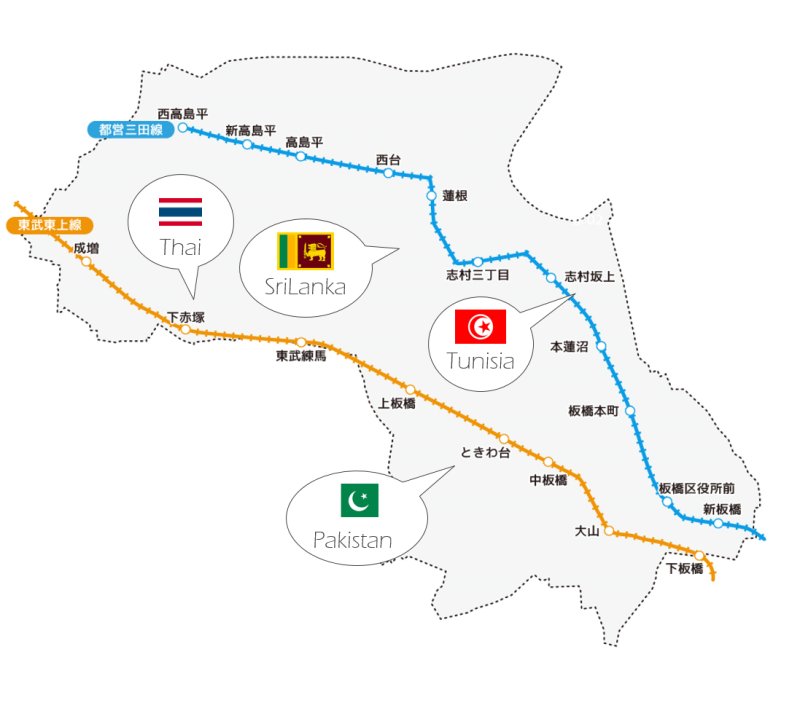
- One of the great pleasures of traveling abroad is to experience the unique food and unusual food culture of the country you are visiting.
Itabashi Ward is home to a wide variety of international restaurants, some of which offer authentic cuisine, while others offer new delicacies through fusion with Japanese cuisine.
Let us introduce you to some great restaurants that will give you a taste of foreign cultures and make you long for faraway lands you have yet to see.
 special feature (e.g. in a magazine)
special feature (e.g. in a magazine)
Itabashi Overseas Gourmet TravelItabashi Overseas Gourmet Travel
People of various nationalities live, work, and study in Itabashi Ward. We will visit four popular ethnic restaurants among the many ethnic stores.
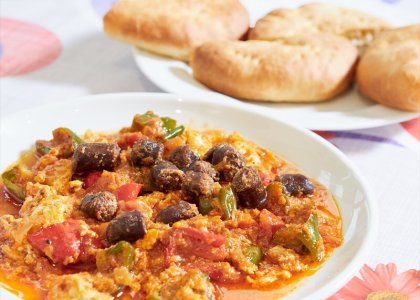
- -Table of Contents-
≪Tunisia≫Brasserie Djerba (Shimurasakaue)≪Tunisia≫Brasserie Djerba (Shimurasakaue)
-

- <
Country name: Republic of Tunisia Official language: Arabic Capital city: Tunis (Largest city: Tunis) Population: 12.26 million (79th in the world in 2021)
Let's say hello in Arabic! Hello: Assalamu alaykum / Selem Thank you: Shukran Delicious! (Radiese: Radiese)
- ≪Brasserie Gerba (Shimurazakaue)
Taste the fruits of the fusion of cultures that has produced a variety of foods.
-
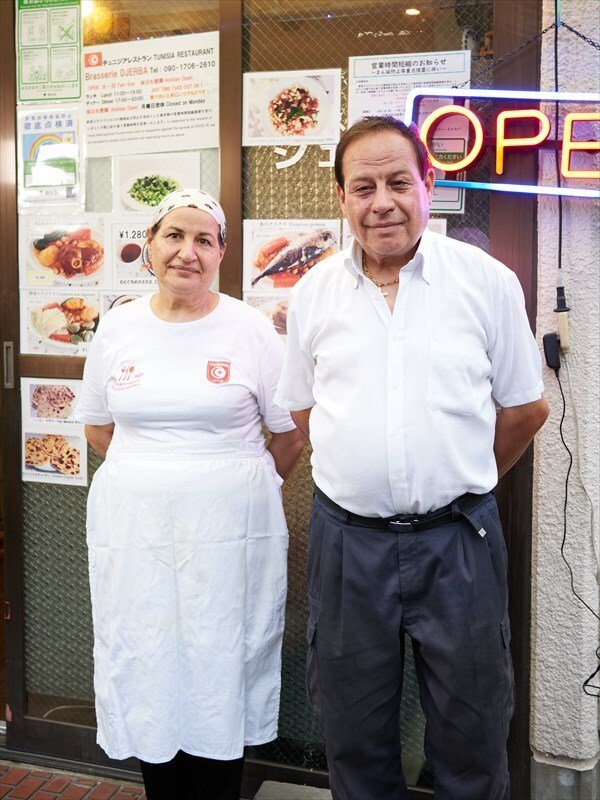
Ms. Ausaui Lida and her sister Lauda
- Tunisia is the land of the proud Phoenicians, who were active in maritime trade around the Mediterranean Sea. Located in the northeastern part of the African continent, Tunisia is just a stone's throw from Sicily in Italy. The network established by the Phoenicians for trade extends not only to the Mediterranean but also to the east and west coasts of Africa and Northern Europe. The letters they used for trade eventually came to be used throughout Europe, and are said to have been the source of the current alphabet.
Brasserie Djerba, named after the island of Djerba, which is a favorite tourist destination among Tunisians, is a restaurant specializing in Tunisian cuisine, which is rare even in Tokyo. Mr. Lauda, who is in charge of cooking, has a varied repertoire of dishes, including home cooking, and is so skilled that embassy staff often visit his restaurant and he also cooks for the embassy on business trips.
-
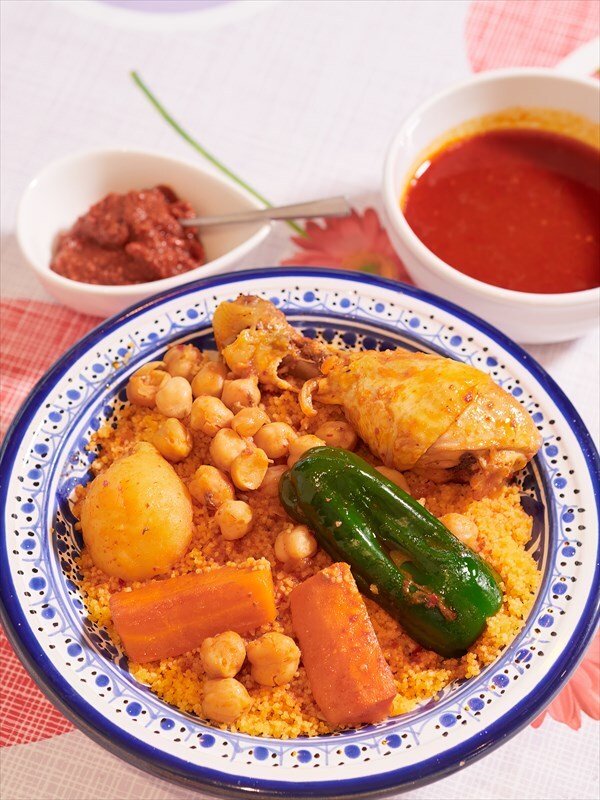
Chicken couscous (1
- Tunisian cuisine is influenced by the Mediterranean culture and uses a lot of tomatoes and olive oil, and since there are many Muslims (Islamists), lamb and chicken are mainly eaten.
Furthermore, the fertile and rich land is peaceful and has not experienced soil contamination due to modern wars, which makes it possible to grow truly safe and delicious crops such as olives.
One of the characteristics of Tunisian cuisine is the extensive use of a seasoning called "harissa. It is a hot and slightly sour sauce based on chili powder and flavored with several spices such as garlic and cumin. It is often poured over finished dishes to taste or used as a seasoning when cooking.
-
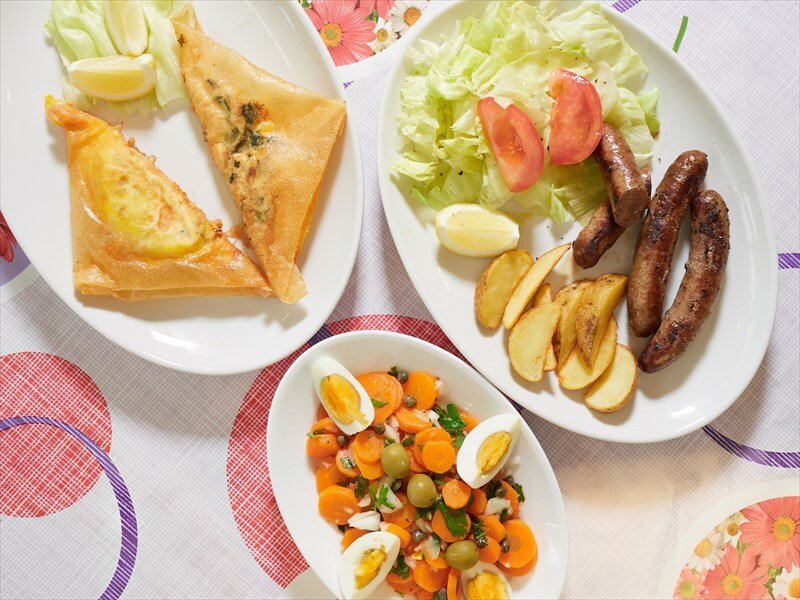
From top left: Tuna Brick (700 yen)
- Tuna Brick is a crispy, light and savory spring roll-like snack made with a very thin crust and deep-fried and baked ingredients. Lamb Merguez is a fresh lamb sausage seasoned with harissa. Salad Horiya" is a Mediterranean salad with plenty of carrots and Tunisian olives, flavored with a refreshing caper.
-

Nodoguro no Musuri (1
- The fish is selected from the freshest fish available at any given time, and on this particular day, the fish was "Nodoguro" (sea bream). The "fish musli" is cooked in a tajine pot, and the plump fish meat has a great spiciness to it. The restaurant also sells tajine casseroles, ingredients, and wine imported from Tunisia.
-
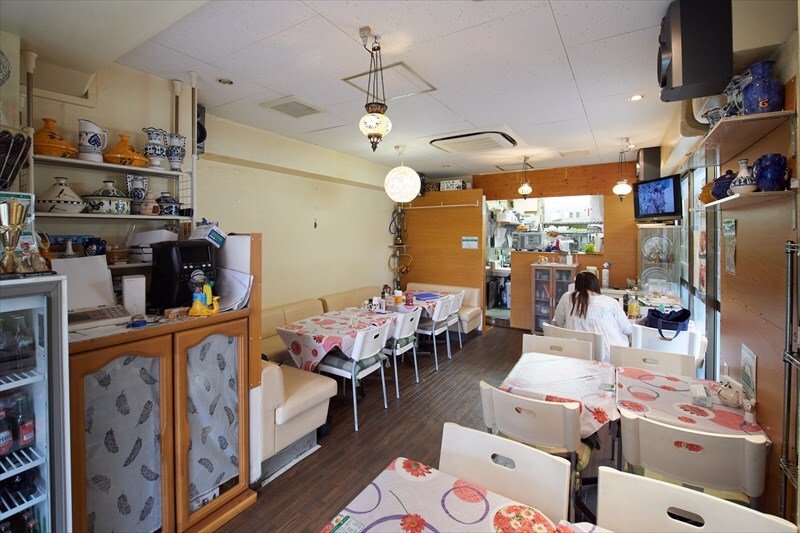
- Brasserie Djerba is also a place of relaxation for Tunisians living in Tokyo, where words we are not familiar with are spoken. Watching local TV programs with a glass of wine in one hand and a comfortable intoxication in the other, you feel like a traveler on the Mediterranean Sea.
Rida says that there are still very few restaurants that are truly Halal, and that they have to stay open as long as possible to support the Halal students studying in Japan. But good food attracts people. Sometimes, she says, the tables are filled with people of different religions. So even if the same dish is served, there are people who eat it with knife and fork, people who eat it with their hands, people who eat it with chopsticks, and there are various ways to eat it, and of course, there are various things that are not to be eaten or not allowed to be eaten. It seems to truly embody the history of the Phoenicians and of Tunisia.
Mr. Lauda, with his gentle smile, is not very good at either Japanese or English (those fluent in French or Arabic are welcome to try the local way), but each table has a menu with pictures and explanations, so you can order with confidence. When you finish your meal and leave the restaurant, be sure to say, "Ladi's! (You are welcome to do so in the local style). You will definitely want to come back again to see Lauda-san, who will smile at you with genuine happiness.
-
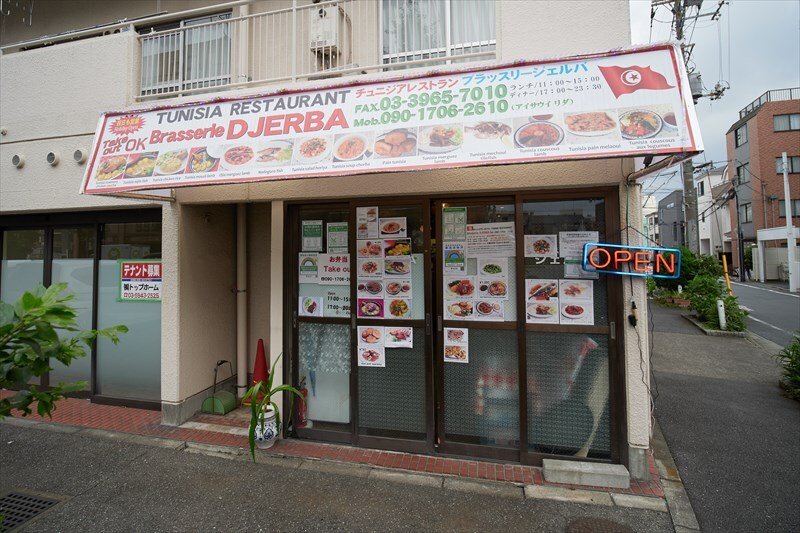
-
Information
Brasserie Gerba
Store Information (Business hours are as of February 2023)
Location: 2-15-3 Azusawa, Itabashi-ku, Tokyo
Closed: Monday (Tuesday if Monday is a national holiday)
Business hours: 11:00 ~ 15:00 / 17:00 ~ 23:30 LO
Phone number: 03-3965-7010
≪Thailand≫Bai Keo (Shimoakatsuka)≪Thailand≫Bai Keo (Shimoakatsuka)
-

- ≪DATA.
Country name: Kingdom of Thailand (Official English notation: The Kingdom of Thailand) Official language: Thai Capital: Bangkok (Largest city: Bangkok) Population: 71.6 million (20th largest in the world in 2021)
Let's say hello in Thai! Hello: Sawadee Kulap (Male) /Sawadee Ka (Female) Thank you: Koopkun Kulap (Male) /Koopkun Ka (Female) Delicious! Aroi (Thai word): Aroi (Thai word)
- ≪baichaew (shimo-akatsuka)
Very popular restaurant with a friendly Thai proprietress
-

Mr. Namfon Eguchi
- Coming to Japan and Opening a Thai Restaurant
Twenty years ago, Ms. Namphong and her husband, a Self Defense Force member who was visiting a port in Thailand, met by chance during a school social studies field trip and exchanged e-mail addresses. After exchanging emails and traveling back and forth between the two countries, they eventually got married. Nam Phong has been living in Japan for 19 years.
Although she is affectionately called "Nam-chan" and "Nam-san" by her customers, she sometimes felt a little uneasy when she first came to Japan. In Thailand, everyone is very friendly to each other, but people I met in Japan didn't exchange a few words with me. Did I do something wrong? I sometimes wondered if I had done something wrong. She and her husband, who was familiar with the temperament of foreigners due to his work, got along very well, but when they got married and came to Japan, she was perplexed by the different attitudes of other Japanese people. However, she soon realized that Japanese people tend to be quiet and shy, and she has completely blended in with the Japanese way of life. She is now the signature proprietress of the restaurant, with a character that brightens up even the shyest Japanese.
-

Pad Thai (800 yen)
- The "gekkitu" flower, from which the name "bai keo" comes, is a neat and very fragrant flower commonly found in cool regions such as Esan in northern Thailand, and is popular among Thai people.
-

Yam Moo Takai (minced pork and lemongrass wrapped in lettuce
- Dishes that "almost taste like Thailand
Namphone's mother, who originally ran a restaurant in Thailand, came to Japan 10 years ago and has been working in the kitchen every day. 60 to 70 dishes on the menu are all locally prepared and "80% Thai taste", she says. The only thing that is adjusted for the Japanese is the spiciness, but recently the number of requests to make the food as spicy as Thai food has been increasing. Many Japanese people think that Thai food = Pakuchi, but in Thailand, it is only used in salads or as a topping for soups, not in large quantities. Please let them know how you like it.
Lunch sets, which are popular with the daily changing menu, come with lemongrass or jasmine tea, orange juice or coffee as a free drink.
Value-priced boxed lunches with a wide variety of side dishes are available from 10:00 a.m. daily, and a number of items are sold out. Many Thai food fans visit the restaurant, saying, "It's hard to find a place that offers such a wide variety of dishes," and most of them order a variety of dishes and enjoy them with drinks in the evening.
If you want to try 100% authentic Thai food, including ingredients, they can prepare it for you if you give them a call. They say that it sometimes takes time to obtain and prepare the ingredients, so if you contact them a little in advance, they will be happy to prepare the dish for you.
-

Lunch Pad Ga Pao Gai (rice with chicken and basil
- Follow us on Twitter for the latest news and special offers!
We post information on Twitter about changes in our business hours and temporary closings.
Please follow us on Twitter for information about special offers, such as discounts on boxed lunches for the rainy day sale.
≪Pakistan≫Let's Eat (Tokiwadai)≪Pakistan≫Let's Eat (Tokiwadai)
-

- ≪Pakistan DATA.
Country name: Islamic Republic of Pakistan Official languages: Urdu (national language)/ English (official language) Capital: Islamabad (largest city: Karachi) Population: 204,293,800 (5th largest in the world in 2022)
Let's say hello in Urdu! Hello: Assalamu alaykum Thank you: Shukria Delicious! Mazaidahl: Mazaidahl.
- ≪Let's Eat (Tokiwadai)
Japan's first fast food restaurant serving Pakistani home-style cuisine
-
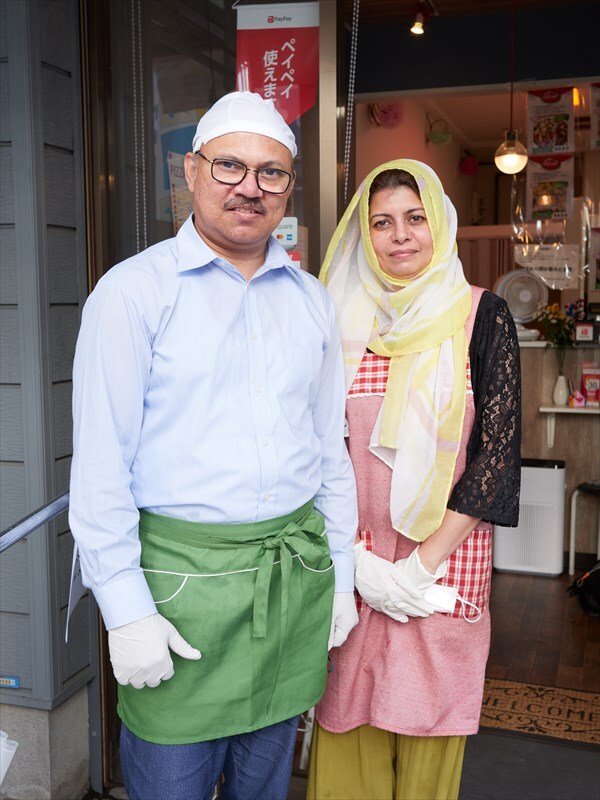
Nadeem Ahmad and his wife
- ■ Coming to Japan and opening a store
Mr. Nadeem and his family, who were engaged in trading business in the capital Islamabad, came to Japan in 2019. When the global coronavirus outbreak immediately after that made it difficult for them to carry out their trading business, they wanted to introduce some Pakistani culture to Japan, so their wife taught Pakistani cuisine in their neighborhood, which became very popular. This became very popular, and she eventually opened her own restaurant.
Mrs. Sarwat's cooking is traditional Pakistani home cooking passed down from her mother. They are healthy homemade dishes made with fresh and tasty ingredients without using any frozen ingredients. She uses a wide variety of spices and cooking methods, and every time Pakistani and embassy officials visit, they are amazed at how she can make so many different kinds of food by herself. They are always amazed at how one person can make so many different kinds of food.
-

Chicken biryani (800 yen) and Robi achat (boiled red kidney beans
- They have known each other since childhood and are very close. The wife says, "It's delicious, so I want you to eat a lot of food the Pakistani way, and for this amount of money in Pakistan, it's this much. The wife says, "It's delicious, so I want you to eat a lot of it the Pakistani way.
The husband, Ahmad, studied in Japan for two years and is fluent in Japanese, and his wife is currently studying. They are both fluent in English, and ordering at the restaurant is easy with a menu with pictures and numbers.
-

In-store product descriptions and order numbers. You can order by pointing.
- Halal: The Right Way.
Mr. Ahmad had considered the United States, Europe, and Canada as bases for his trading business, but he chose Japan as a safe and clean country where Muslims would have no difficulty in blending in and coexisting with other religions.
The Islamic "halal" that we hear so much about these days is not only about food, but also about right conduct and right methods. Halal is a teaching for a healthy and sound mind, for a peaceful and clean life. Everything on the menu at Let's Eat is Halal food, not just the recipe, and when you actually eat it, you will realize that it is very good for your mind and body.
-

Dahi barai (dumplings made of kneaded chickpea flour

onions
- The Dream of Pakistani Food from Japan
Currently, we are only doing take-out business to prepare for Corona, but we are planning to start mobile sales with a kitchen car to bring the taste of Pakistan to many people, and we are preparing to expand our business in earnest to offer burgers, biryani, and other dishes.
After Corona, I would also like to find a larger restaurant and hire a chef to help me with dining. Once the restaurant is spacious, I would like it to become a hub for cultural and human exchange as well as a bridge between Japan and Pakistan.
- It's a tiny store now, but this is little Pakistan. If you want to experience the taste of Pakistan, the feeling of Pakistan, please come here," says Ahmad.
If we succeed in Japan, I would like to open a chain of Pakistani fast food restaurants around the world. Even the most famous chains start out as one small restaurant. This is my dream!"
≪Sri Lanka≫ Rogers Kitchen (Hasune)≪Sri Lanka≫ Rogers Kitchen (Hasune)
-

- ≪Sri Lanka DATA
Country name: Democratic Socialist Republic of Sri Lanka Official languages: Sinhala, Tamil (national language and official language)/ English (widely used as a lingua franca between the two ethnic groups) Capital: Sri Jayawardenapura Kotte (largest city: Colombo) Largest city: Colombo) Population: 22,163,000 (60th in the world in 2021)
Let's say hello in Sinhala! Hello: Aayubowan Thank you: Stuthi Delicious! Rasai: Rasai!
- ≪roger's kitchen (lotus root)
A "new" modern Sri Lanka born from the encounter of passion for food and harmony
-

Mr. Roger Diaz.
- My aunt who was working in the Ministry of Foreign Affairs of Sri Lanka was sent to live in Japan by the Sri Lankan Embassy in Japan. She invited my sister to Japan and she got a job as a secretary at the United Nations University. I visited my sister in Japan as a tourist and fell in love with the country and attended Japanese language school in Sri Lanka.
I stayed in Sri Lanka until I was 20 years old, but I really had no "real" interest in cooking. I just ate because I was hungry. After coming to Japan, I worked as a waiter and occasionally cooked simple dishes in the kitchen, but it was only in the last 10 years or so that I started to develop a lot of ideas about cooking.
- When I was working at a restaurant in Nishi-Azabu, I studied service very hard. What I learned there was that the menu is a catalog and the wait staff are salesmen. How do you sell the food to the customers and make them satisfied and become repeat customers? I learned to always think about true service and hospitality for customers."
-
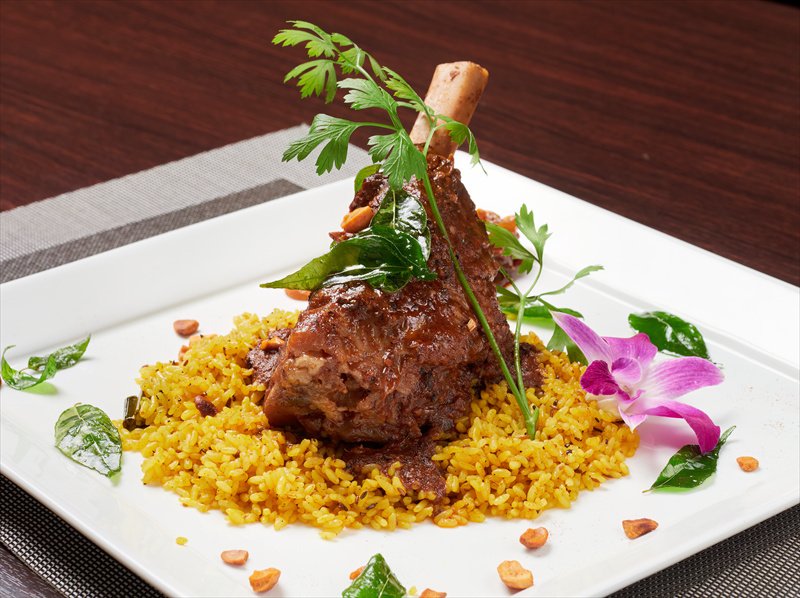
Lamb on the bone biryani
- Since my interest in cooking was born, when I go back to Sri Lanka, I don't stay at my parents' house but go to hotels and eat at reputable restaurants to study the taste of Sri Lankan cuisine. Sri Lanka has a diverse ethnic population, and each ethnic group has its own cuisine, use of spices, and food culture, which is interesting.
When I cook with inspiration from Japan, I realize that the various cuisines and spices used in Sri Lanka are actually alive inside me."
-

Garlic Achard" from One Day's Omakase Course
- Even now, when I have time, I try to come up with new ideas for dishes.
I am afraid to keep making the same menu and the same dishes.
What if the taste is blurred? Will I be able to maintain the same taste?
It's hard to keep making the same dish every day.
-

Shrimp Curry Beef Noodles" from One Day's Omakase Course Homemade Beef Noodles steamed in a steam convection oven
- I was told, "Eventually, customers would say, 'Why don't you try doing your own course?' I am now being told, "Why don't you try your own custom-made course?
By continuing to bring out new flavors and challenging myself, I can raise my own level, and my customers can always enjoy it. I thought that was wonderful.
What I am aiming for is "modern Sri Lanka," not street food or soul food.
I want people to experience the new use of spices in Sri Lankan cuisine, the newest movement."
-
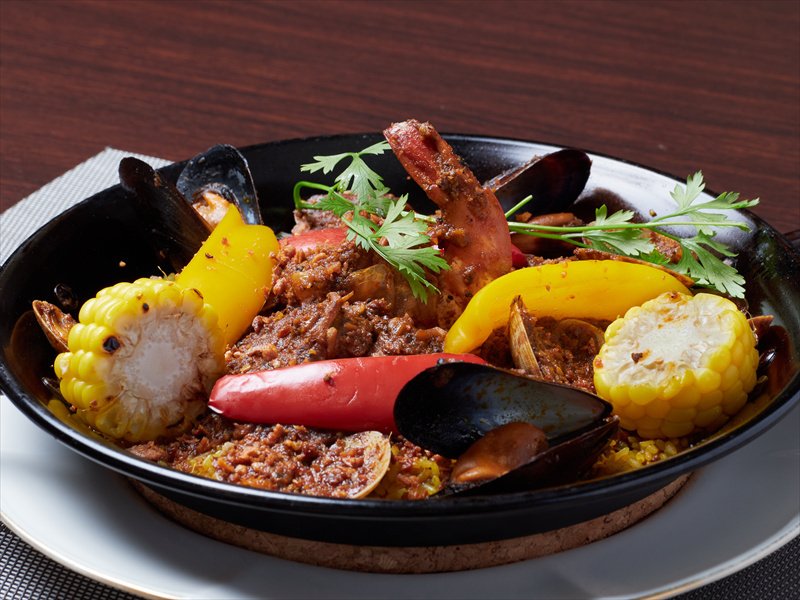
Mixed Seafood Rice" from One Day's Omakase Course
- We want to control various factors such as taste, ingredients, spices, use of oil, and temperature. I also want to create new tastes by fusing Japanese ingredients, cuisine, and food culture. I have never studied the basics of cooking, and I think that is why I am able to challenge myself to think freely from scratch.
My father actually arrived in Japan before my sister. We are a sports family and my father represented Sri Lanka in the marathon at the Rome Olympics and the Tokyo Olympics. I guess my father guided me to the path that I am now cooking in Japan.
-

Deep-fried shrimp kadaif" from one day's omakase course
- The values we experienced in the city center won't work here. We have to work with new values. In Nishi-Azabu, there were customers who ate lunch for 1,500 yen every day and paid 3,500 yen for parking, but here it's the opposite, so they can eat delicious food more slowly for that amount.
It may be a hassle to come by bus, but you will have a great experience there. I want to challenge myself here to see if we can create a new network, a system where the community and residents need each other."
- Japanese chefs all work with pride, but unfortunately most chefs in Asia do not. Once the dish is cooked, it's done. A customer left it, I wonder why? Is it because they are sick? Maybe it didn't suit their palate? Maybe it was a little difficult to eat. I don't even think about that. I don't try to be creative.
My cuisine is the result of learning a lot from Japanese food and Japanese chefs. My cuisine is a fusion of Sri Lankan tradition and Japanese wisdom. It is not a Sri Lankan restaurant. It is my own cuisine that was created when I met Japan. That's why I named it Rogers Kitchen."
- Text and photographs by Tsutomu Ogasawara
- The menus, prices, and other information in this article are current at the time of the interview. Please check each restaurant's website for details.
The next feature will be
How was your Itabashi overseas food trip?
We look forward to seeing you next time.

